-
Play Therapy at Home: Day 13 Teenagers and Feelings
I realize it’s been a long time since I’ve written. Life happens and you have to make room for it. In the time that has gone by, though I have some new things to address. I’ve done several basic play therapy ideas for small children and I thought I would address some teenager issues. I have been working with parents of teenagers a lot lately. I fully admit that I am not one yet, but I hope that won’t discourage you- in fact I love the feedback from those who are “in the trenches”. I can give you some ideas and insight from what I like to do in my office with the teenagers I am seeing, though.
Social media is KILLING our youth. I would have to address this in multiple blogs, but for today I want to address the expression of feelings. I know that sounds sappy, for those who aren’t in the counseling world, but expressing what’s going on inside is crucial to the art of communicating, your self-esteem, being understood by others, and relating to others. Social media, texting, technology are deteriorating basic communication abilities. When you are constantly able to edit your response, you never have to think on your feet. You can text, erase an email before sending it, or wait to respond. Teenagers are having an emotional response inside and are limited on their ability to express it out loud. Some of this is developmental as they still think like a child, yet want to be treated like a grown-up. Expecting them to automatically know what they feel and express it, let alone know what to do with it is too high of an expectation. What teenagers need is help identifying their feelings, adding more words, and then practice communicating it.

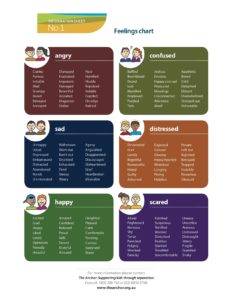 An intern that works with me came up with a fun idea for one of the teenagers we were seeing who had this exact goal. When she first came in, like many of the teenagers I meet, their blanket feeling words are “happy, frustrated, angry, and upset”. But most of the time, their answer is “I don’t know”. So we first introduced the feeling chart. I found a good one here that’s included in the PDF that has some extra information within.
An intern that works with me came up with a fun idea for one of the teenagers we were seeing who had this exact goal. When she first came in, like many of the teenagers I meet, their blanket feeling words are “happy, frustrated, angry, and upset”. But most of the time, their answer is “I don’t know”. So we first introduced the feeling chart. I found a good one here that’s included in the PDF that has some extra information within.Because young teenagers enjoy games still, we used skittles and M&M’s as bait 🙂
Actually, we (using the feelings connected to colors that I have mentioned previously), had the teenager assign feelings to each color. Of course, we expected the feelings she chose to be her usual generic ones mentioned above. Then we took turns picking up a piece of candy (with our eyes closed to prevent avoidance of certain colors) and told about a time when we felt that emotion. From a therapist perspective, it is usually ethical to avoid too much disclosure, but when working with teenagers, it helps model the normalcy of experience as well as establish a safe relationship. I would definitely encourage parents to tell their story, yet try to not date themselves. Choose stories that they can relate to.
To take it to another level, I asked the teenager to try using three extra “feeling words” to describe her feelings during the story. “Upset” can be broken down to embarrassed, overwhelmed, and discouraged. Then, once they are finished with the story, I asked, using those words, how would she communicate her feelings to [that] person.
So, for example… I’m completely making this up…
“Mom, when you yell at me, it makes me feel overwhelmed, scared, and discouraged.” Which is MUCH better than “My mom makes me upset.”
Of course the next level, which I would recommend you try later once your teenager feels confident in identifying their feelings better, is trying to think out how they would ask their Mom to try something different. This not only takes great courage, but a humble parent who is willing to see their own opportunities for change. Many of the serious issues I see with teenagers are not just a problem with the child. Rarely is it only them, it is usually a family dynamic problem. I am often forced to carefully address the parents and talk about what changes they need to make in order to see their teenager’s behavior change.
I hope to write much more on this in future blogs, but for now let me encourage you with this. Your teenager still has a child brain that cannot think through the future. They cannot see or think out consequences or often solutions for what they feel. That is hard to keep in mind when they look on the outside like an adult. The best advice I can give is this…
Your teenager wants you to treat them like an adult for the things they know how to do and have proven/earned it. They desperately need your help in teaching them on the things they do not know how to do and enjoy being taught when done in fun ways that involve quality time with you. Deep down inside, they need to be loved like a child, especially in private. This doesn’t necessarily mean physical affection- but more tending to their heart by acceptance, affirmation, loving them through their mistakes, and caring about what they care about. Don’t let the “front” on the outside, convince you otherwise. They just don’t know how to ask for it without negating that they also want to have some adult responsibility. As confused as you may feel, so are they- so just love them anyways!
 Here is another resource that I found that I hope to use in a future session. This would be great for group settings if you are involved in a youth group. Speaking of that- I will try to write a future blog on the Power of Peers, too!
Here is another resource that I found that I hope to use in a future session. This would be great for group settings if you are involved in a youth group. Speaking of that- I will try to write a future blog on the Power of Peers, too!As always, comments are great!
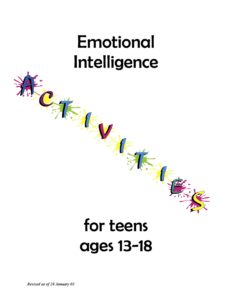
-
Play Therapy at Home, Day 12: Parent with PTSD
I have been thinking about this topic for a while. My counseling practice tends to run in themes. Sometimes a majority of my clients are dealing with loss, sometimes domestic violence, and lately parents struggling with Post Traumatic Stress Disorder (PTSD). It hasn’t helped that our first deployment was in the media recently for some additional awards going to some of our soldiers. As awesome as it is, and I am so proud of our soldiers and families, it has “uncorked” some feelings across the board. Traumatic events in our lives never fully go away. We hopefully learn to deal with the emerging emotions and physical reactions to it better, but life has a way of “uncorking” it at unsuspecting times.
PTSD involves a variety of symptoms that occur in a person’s life when they are exposed one or multiple times to a traumatic event. Symptoms can range from irritability to rage, anxiety to avoidance/phobias, and trust issues with others, among other symptoms.
For more on what PTSD is and symptoms associated with it, click here. I’ve covered in a previous post some ideas on how to work with children who have been through significant trauma. But how do you work with children when they are trying connect with a parent who is struggling? Parents who are struggling with PTSD from an event or multiple traumas can often struggle with anger, tend to withdraw, and react in ways that make a child feel unsafe.
Most often, this is a time for family therapy- an opportunity to work with the family system, the marriage, the relationships between parent-child, etc. Working around a military culture, I have a lot of mothers who bring their children for play therapy to sort out the experiences the children have had with a father who have PTSD from combat. So, in this post, I am going to use “him” for the struggling parent- not to say that a mother couldn’t be the one struggling.
Because there are so many unique family dynamics, it’s hard to be too specific on how to work through play. But, I think we can all relate to a degree. Family and relationships are messy. We all want to have a great connection with our kids, but because we are ALL flawed- we will have experiences with them where our connection will be damaged. The important thing to remember is that we are not responsible for our spouse’s connection with our children. They are. That is super hard to believe. We somehow take on their decisions as a reflection of us because we love them and have a marriage with them- but you simply cannot take ownership for all of their decisions. If a spouse does something to hurt their relationship with their child- there is nothing you can say to your child to heal that connection. Comfort and be present with them? Yes, but true healing happens between those two. Explaining to a child the basics of what the other parent is struggling with helps, but making excuses, or taking them the park extra doesn’t heal it all. That bond will not fully heal until the two of them do it themselves. Military wives understand this to the extreme when they attempt to be both parents while the soldier is away. She will soon find out in the midst of exhaustion, that there is simply no replacement- you do your best to be your best. Have patience and trust timing ans wisdom. It may not happen in the time you want it, but can eventually happen in a moment, over time, or as it is periodically revisited.
That may sound discouraging for you, but when you think about it- it is quite freeing. When you think about your childhood- don’t you think about how you would have loved for your Dad to swing you off your feet, or taking you for that fishing trip, or your mom to hold you during that difficult time? Do you remember anyone else standing in that gap that healed that wound? No. Community helps, other mother-figures or father-figures impacted your life and helped you develop into a fine person, but when it comes down to it- our parents were flawed because we ALL are flawed. All of our children, including mine, will benefit seeing a therapist someday because there is something about realizing we are all flawed that is disappointing, gives us permission to forgive ourselves for not being perfect, and then goes on to heal our relationship with God and humanity. God is the only one that is perfect, the rest of us have to figure out how to reconcile with the rest of the world.
So, the first thing is that if your spouse (who is struggling with trauma) is doing ANYTHING unsafe- you must follow your responsibility to children who count on you to protect and teach them boundaries in life by making sure they have a safe environment to live in- so that the parent dealing with trauma doesn’t create a new trauma for the child. God made you- just they way He wanted to- amazing and wonderful. He made your children that amazing too (why do we see our children made more wonderfully than us?). He would want you to protect yourself and your children. Period. You have permission- from God- to protect yourself and your children from abuse and dangerous behavior.
Now that I said that, there are behaviors (like responding in isolation, drinking heavily, rage) a struggling spouse may do that make home environment difficult to live in. Without going into all the family dynamics and adult dynamics, I will give you things to try with your child to help identify what they might be feeling and then teach them how to communicate it.
With PTSD, there are “triggers”-a normal daily task or experience that brings back up memories and sensations of the trauma. Because all of the sensory areas of the brain light up during trauma for the sake of survival, memories are captured in those senses. This is why when the memory comes up, the person feels, hears, sees, smells the memory like it is happening in the present. Because of this, their body escalates with adrenaline (survival again) and then they react. As a family, it is important to be compassionate and understanding. However, when it begins to feel like walking on eggshells, or keeping a bomb form exploding- you are talking about the family suffering too.
Teaching the kids to be respectful and mindful is always great, but children of parents who struggle with PTSD will sometimes take on adult responsibilities by taking care of the parent. I once had a child who knew to bring his mother water when she would have panic attacks. Although I see nothing wrong with this kind of compassion, if he began to take on extra adult responsibilities around the house, or tasks the mother should be able to do for herself it can become unhealthy. One of the things he was struggling with was developing his own anxiety while at school. Who would take her water if she had a panic attack? It was then that mom began to see that she needed to both get treatment as well as assure him more that he was being helpful, but that she would learn to cope when he wasn’t there.
Telling details of the trauma to the child can vicariously traumatize the child. If your spouse wants some time to share the memory, respectfully asking for a time out long enough to find an activity for the child to do is being respectful of both.
I would encourage the children to draw or paint pictures on separate occasions of the family, them with the struggling parent, as well as how they see the parent. Talk with them, don’t ask leading question (i.e. That makes you sad, doesn’t it?). Instead, ask them to describe their picture. Ask them to tell you about their favorite things about you and your spouse. If they talk about any feelings they have that would show concern for their connection being broken with the other parent, ask them if they ever feel like they could talk to him about that. Have a conversation where you don’t do the work that dad needs to do, but that you just listen. Children often just need to feel heard and understood. Ask them what they would like to see different between them and their Dad or in the home.
One of the signs of maturity as an adult is the ability to confidently communicate how we feel, especially in a relationship. In marriage and in work, we need the ability to sometimes ask for change and express concerns. As parents, we are teaching our children how to eventually do that. For some reason, we feel the need to protect them from having hard conversations. Do you ever ask your children what you could do to be a better Mommy? Try it sometimes, their answers are priceless and often not what you would expect. Creating these times for open dialogue can make it easier for kids to talk as they get older, and develop confidence to ask for something to change, to express hurt, or have the tough conversations that sometimes don’t happen in life.
If you feel your spouse is open to it, encourage your child over time to “show his pictures to Daddy and talk about them” during an open and safe moment when the spouse has been prepared for it (it is never a good idea to ambush or surprise your spouse). Of course, I am not advocating your using this in a manipulative way, but encouraging your child to own their relationship with their parent. It may not always go smoothly, but communication never promises that either. If they feel uncomfortable, you could offer to be there with them. Now that might scare some of you, fearing it would create conflict. As difficult as this is to sit through, it is the weight of seeing our consequences that often causes us to try something different. If they responded to you question about being a better Mommy, with “I wish you would put your phone down” that would feel awful, wouldn’t it? But would you feel that the next time you picked up your phone around them?
If you feel that your child talking to him could cause intense destruction, then using counseling as a neutral territory could be beneficial to everyone. Until then, using play therapy as an outlet for your child to express his anxiety and other feelings could be helpful.
The important thing is that the children have an opportunity to process feelings in a safe place, teaching them to somehow communicate it to others, and for the right people to feel the weight of their own relationships with each other. It is in that space that people begin to make the choice to build (sometimes by getting help) or continue to destroy those around them.
By the way, if your spouse is doing something right… encourage them today by telling them so! We all need to hear it. Even if a spouse is struggling- let them know what they are doing well and what you think is going right so they know to keep trying. Fighting for your marriage and family takes initiative on both parts, patience, community, help, and the right tools to bring purpose out of any situation. I would love to hear what you have learned!!

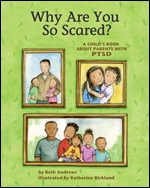 Why Are You So Scared?: A Child’s Book About Parents With PTSD By Beth Andrews, LCSW
Why Are You So Scared?: A Child’s Book About Parents With PTSD By Beth Andrews, LCSWWhen a Child’s Parent has PTSD
Understanding PTSD in Children and Teens
New Changes in DSM related to PTSD
-
Play Therapy at Home, Day 11: Fear and Loss
I have been thinking a lot about loss this week. Not only are some of your families dealing with loss in various ways, Fort Stewart lost more soldiers this week in Afghanistan. I used to refer grief issues to other therapists. At the time, I had not lost anyone close to me, I didn’t feel like I could relate enough to someone coming to me for help. But after walking through the swamp of sadness (Neverending Story) with others enough times, you begin to realize that grief is something we all can relate to. All of us have lost something- a loved one, a pet, a dream, a relationship. The feelings that come with that loss are mostly the same, just heavier the closer the person was to you. If you are not careful, the overwhelming feelings of grief can cause you to fear death- or rather feeling overwhelmed at the thought of the emotions that follow. I know I was tempted to be afraid and know others who struggle with anxiety that keeps them from living fully in the moment. I am going to share a technique with you, but I think it is more important to share thoughts and words. It is often the conversations with our children that are the most healing.
Helping children cope with loss is a family issue, not just one with the child. Ultimately, it brings up what you as a family believe about loss, death, and what happens after death. It is full of teachable moments with your children where they are needing to be taught the answers to those questions. If you don’t know the answers yourself, you will find yourself struggling and unable to walk into that swamp with them. There is no escaping suffering in this life, and grief eventually will become a friend of ours. That doesn’t have to seem depressing- in fact- I think it is in the pocket of grief that we are truly alive. The overwhelming feeling of grief is evidence that we loved someone, something, or had hope in something. What a wonderful thing to say! That overwhelming feeling of heartbreak is not something to fear, it is something to fully embrace and experience- it is what connects us that point forward with the person we lost.
I tell families all the time that if you don’t allow yourself to feel, those feelings don’t go away. You push them down and pack them in. Like a Coke bottle, they will eventually leak out or explode when life shakes you up (sometimes on a daily basis). Letting it out in healthy ways releases the pressure and gives you a better perspective on everything. So, when working with the child, encouraging them to fully cry when their emotions are pricked will let out some of the pressure. I don’t know about your kids, but Aidan seems to only feel his emotions when he is triggered by something- it is then that everything else that he has been feeling comes out with it. One good cry and he feels better. Jack on the other hand, will handle disappointment by thinking up everything else under the sun to also be upset at and snowballs. I remember his feelings getting hurt by someone and him crying about how he never got a yellow umbrella- A yellow umbrella? He never asked for a yellow umbrella! The point is, sometimes our children will have their emotions pricked by hurt feelings at school or disappointment and everything else will come out. Instead of pointing out their irrational thoughts, consider letting them release the pressure and talk about it with them afterwards. We adults do the same thing, bickering with our spouses, gossiping about others, and snapping at our children- all because there is something else going on inside.
I would definitely recommend some of the previous play therapy techniques in the previous days to sort out the feelings the child is having. I love to have children draw where their loved one is and talk about what it is like there. Often times, you will hear children want to go there and be with them. This doesn’t have to be alarming- it is their concrete way of processing their loved one being in a different place. When Daddy is on a business trip (and is not physically in front of them), it makes sense to fly on a plane to see him- why not take a plane to Heaven?

 When my Granddad passed away, it was hard on all of us. I knew this was going to be my first experience of intense loss and had feared it for a long time. Matt has been amazing in walking me through it all and I have learned so much from him. After losing several friends in Afghanistan, he had already walked hand in hand with death. When it came time, I can look back and say I worked hard to take his advice as well as my own. I fully embraced those moments of initial loss. I didn’t try to be strong for anyone (unless I felt capable and wasn’t pushing things down) and made sure I let my children see me cry, saving the worse for private moments. I can honestly say that I can look back on that time as a sweet time between me and my Granddad.
When my Granddad passed away, it was hard on all of us. I knew this was going to be my first experience of intense loss and had feared it for a long time. Matt has been amazing in walking me through it all and I have learned so much from him. After losing several friends in Afghanistan, he had already walked hand in hand with death. When it came time, I can look back and say I worked hard to take his advice as well as my own. I fully embraced those moments of initial loss. I didn’t try to be strong for anyone (unless I felt capable and wasn’t pushing things down) and made sure I let my children see me cry, saving the worse for private moments. I can honestly say that I can look back on that time as a sweet time between me and my Granddad.When a loss doesn’t happen naturally, but suddenly and with unanswered questions, the grief that follows is often called complicated grief. The normal grief process is dragged out, can effect the community of support, and leave a person with far more questions that answers. Reflecting on the connection with the one we lost can help ease the pain when it is triggered again and again. I encourage parents to help the child make a book of positive memories through art, photos, and stories that will help bring back memories that will fade over time. It can be kept in a safe spot and taken out periodically when needed and given as a gift when the child is old enough to care for it.
After encouraging your child to feel his or her feelings, it is important to communicate what you believe and want your children to understand about death. Talking to them and finding out what they have heard from other adults is important, as they may have heard conflicting things from others. Sometimes children will explain death to me and use adult language they overheard, all the while not understanding any of it. Here are some questions to think about when talking to your child. By the way, we adults struggle with these too, so getting help to resolve these within your own life may be simultaneously important:
- How can this person be both in Heaven and in the ground at the same time?
- Someone said God wanted her with Him, why would God take her?
- Will it happen to me?
- Will it happen to my parents?
- Can I pray to him or her?
- If Heaven is such a happy place, I want to be there too.
You may see your child regress and have some separation anxiety- this is normal. Giving your child a sentimental object to hold on to is completely okay. The thing your want to look out for is whether it is interfering with their functioning after the initial stage of grieving. Can they go places without it where it wouldn’t be appropriate? Helping them wean when they are ready will be a healthy part of the grief process as they begin to transition from the object as connect with their loved one and instead through memories. This is similar to a security blanket and can relieve anxiety if grief is coming out as fear. Think about weaning your child from a pacifier- it will be a similar experience of patience and understanding.
One of the best things Matt prepared me for was how much easier it would be to connect with my Granddad after he was gone. I didn’t get it until after, but there is something comforting about connecting with him whenever I think of him now, and not having to try to call him on the phone- and that is something special. Some people feel better “talking” to the person they lost- not necessarily because they feel they can actually hear them, but because their spirit is not contained in the body anymore. Sometimes not having all the answers to the afterlife gives us the freedom to do what we need to do to grieve.
One of my favorite techniques is using balloons. I remember doing this technique with adults as well and it seems to work no matter what the age.
It’s very easy. The child can write a letter or draw a picture to give to their loved one. Take it to your local grocery store and ask them to stuff it inside a helium balloon. Let the child release it! As easy as it is, there is something wonderful about releasing those words and feelings into the sky. Parents sometimes look at me like “Is this really going to help?” and then come back in tears saying it was powerful for the whole family. Even when you are old enough to know that your letter isn’t actually going to “get there”, it still feels somehow like it does. Let the younger children believe it- there is something powerful in the imagination!
You can also do variations of this technique more frequently if you’d like:
- Writing letters and burning them
- Writing a message on the loved one’s social media page
- Sitting with others who are grieving the same loss and sharing stories
Don’t forget anniversary dates. There is an internal clock in our bodies that we are not conscious of. Have you ever had a rough day and then looked at the calendar to find out it was an anniversary of a loss or tragic moment in your life? Mark your calendars so they don’t surprise you or your children. Plan both meaningful events and unrelated events that get you out of the house and with other people that day. Step in, feel the connection, and then give yourself opportunities to step out of it.
Here are a few resources that I like:
For an incredible list of statistics on children and grief:
National Poll of Bereaved Children
A Developmental Chart on Children and Grief
A List of Do’s and Don’ts When Talking to Children About Grief
Brene Brown gave an EXCELLENT Tedtalk on anxiety that keeps us from experiencing joy:
{youtube}_UoMXF73j0c{/youtube}
Click Here for iPhone, Ipad, or Apple products
-
Play Therapy at Home, Day 10: Anxiety
This is the half way mark! It’s hard to believe, it has been such a wonderful journey- and easier than I thought. In fact, the hardest part is finding the time to blog about it and design the page. In other words, if you haven’t tried some of these ideas, they only take between 5-15 minutes. Of course you can go on longer, but sometimes that’s all the child can handle with their attention span.
After taking a Sabbath break over the weekend, we decided to jump back in. I asked some of you what issues you would like to see and wanted to respond to those. Keep your thoughts and ideas coming so I don’t just use our own experiences that may not relate to what you are going through. I am looking towards focusing on loss, attention, anxiety, and past bad experiences (trauma) in the coming days. Obviously one play therapy experience isn’t going to change the issue dramatically, but when you do several over time, spending quality time with your children- you can see the difference. In fact, unless I am dealing with a traumatic issue that happened with the family, most children in the end are just needing their parents to slow down and spend time with them- that is where all healing happens.
When you think about it, kids are just little people and adolescents are just bigger little people. Many of the things that help adults are skills that can help children, its just that we as parents are supposed to teach it to them. Expecting them to handle hurt and anxiety like an adult is unfair. I guess that brings up the point that we as parents better have some coping skills ourselves in order to teach them!
Children can experience anxiety surrounding lots of things. Meeting friends, starting the school year, upcoming changes, fear surrounding a parent’s anger or loss, trying something new, etc. Sometimes it’s hard to tell when they are feeling anxiety because it may not look like the way adults show it- or does it? When a child is struggling you normally see them regress back into a previous developmental stage (potty trained children begin to wet the bed again, fighting with their siblings more than usual, nightmares, baby talk, clingy behaviors, etc). One of the greatest things you can teach your children is how to get the nervous energy out of their body and relax. Relaxation therapy sounds silly and can feel awkward to do, but it is easier than you think and kids really enjoy it. Visualizing emotions and knowing what to do with them also teaching self-control and what we in the psycho-babble world like to call self-regulation. In layman’s terms it just means we all have a certain amount of responsibility for the emotions we feel and controlling them in healthy ways.
Adults who do not have good self-regulation tear up their relationships with rage filled anger, manipulation, and passive aggressive attempts at controlling others around them- all while blaming the other person for the feelings they have.
We are not superheroes (even though I regularly become Wonder Woman in this house and wish I was). We need others, need community, need support. We are built that way. There comes a point where we all need others to get through something that is beyond our own ability to cope. However, we owe it to our amazing, supportive community (and protect them) when we do our best to regulate (manage) our feelings first before asking them for help. Teaching your child how to calm him or herself is a powerful step towards self-regulation and healthy boundary setting in their relationships.
Today, I wanted to guide my boys through relaxation therapy before bed. It’s not hard and you can’t really mess it up. In fact, we had a good time giggling through some of it! Here are the basics:
1. Help them visualize a place where they are completely happy (My boys were thinking of Disney World and Legoland). Ask them to close their eyes and think about the colors they see, the warm sunshine on their skin, whether or not people are around them, the smile on their face- then we are going to come back to that thought.
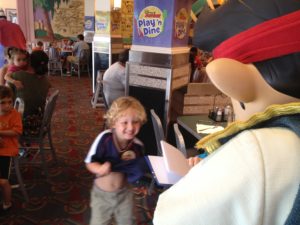
2. Breathe three times through your nose and out through your mouth, each with a count of three. This will be practice for later.
3. Keeping your eyes closed (this is where the giggling begins), starting with your toes by curling them and tightening your foot as hard as you can as you count to 5, then relax using the breathing we learned. Move up to the legs- since kids are still learning to feel and control certain muscles I did the whole leg, where as adults you move muscle to muscle (calves first, then to quads). I found it was easier for them to cross their legs and squeeze their legs together as tight as possible. Move to the buttocks (this is where we really started giggling), to the tummy, and then to the arms. For arms, I asked them to cross them over their chest and give themselves the biggest hug they could, then flex their muscles, and then to their hands- of course don’t forget we are relaxing and breathing out before each one.
When we got to the hands, I asked them to picture any bad feelings, worries, fears, or yucky feelings from the day (give them a moment to think about it) and picture putting all those feelings into a red ball in their hands. Then I had them squeeze their hands together (or as fists) like they are squishing that red ball as hard as they can. Then when they relax, the red ball is gone. 4. Finally, it’s time to think about our happy memory again! Remind them of what they saw there, how they felt, the warm sunshine, the smile on their face again- and Ta-da!!!! It’s bedtime… I didn’t hear from them again.
4. Finally, it’s time to think about our happy memory again! Remind them of what they saw there, how they felt, the warm sunshine, the smile on their face again- and Ta-da!!!! It’s bedtime… I didn’t hear from them again.At the very least, this is a great technique to introduce to them as school is starting. If you practice it ahead of time, try using the hand clenching and breathing throughout the day- this is definitely something they can do in the classroom. When you see your child panicking, having a tantrum, and beginning to get worked up, you can remind them of the breathing. By the way… it wouldn’t hurt for us adults to try this as well…
What is your happiest memory???
-
Play Therapy at Home, Day 9: Distracted, Games for Attention Building
 I know I’m not the only one who has a child that struggles with attention. As we approach the first week of school in two weeks, I know what’s coming. The first month, the new teacher will talk to me about how Aidan gets easily distracted by everything else in the room. He is definitely not hyperactive, but will “Space out” and start thinking of who knows what rather than the boring lecture in front of him. I will talk with the teacher about this, again. Thankfully, he will have the same gifted teacher for the third year in a row who will tell me that he is struggling to stay on task, but it’s just the first month. For the last several years, this is the pattern. He struggles through out the first semester and somehow starts to gain self-control by the end of the year and then summer starts. I am definitely one of those parents who would love year round school, just to end this cycle.
I know I’m not the only one who has a child that struggles with attention. As we approach the first week of school in two weeks, I know what’s coming. The first month, the new teacher will talk to me about how Aidan gets easily distracted by everything else in the room. He is definitely not hyperactive, but will “Space out” and start thinking of who knows what rather than the boring lecture in front of him. I will talk with the teacher about this, again. Thankfully, he will have the same gifted teacher for the third year in a row who will tell me that he is struggling to stay on task, but it’s just the first month. For the last several years, this is the pattern. He struggles through out the first semester and somehow starts to gain self-control by the end of the year and then summer starts. I am definitely one of those parents who would love year round school, just to end this cycle.Matt and I re-evaluated our game plan this past week. We are cutting way back on any video games to almost none at all. I know this is a debate that is wide spread for parenting right now and so this post is not about that. For Aidan, that “world” easily gets stuck in his head and we have a hard time pulling him out. We are outside more than ever and engaging in every bit of peer social interaction as possible and looking into martial arts for the fall. So, in thinking about play therapy techniques that are more teaching oriented rather than interpretive- I took to researching building attention span.
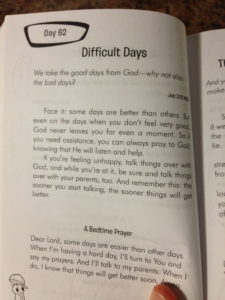 One that I found, I was a little hesitant to try. Honestly, it sounded somewhat torturous. Yet, the more I thought about it, the more I realizes anytime you want to build a skill (and self-control is definitely one) you have to practice and put forth the effort- hopefully with a reward! So the game I found involves the child building something while avoiding distractions. Here’s how we did it:
One that I found, I was a little hesitant to try. Honestly, it sounded somewhat torturous. Yet, the more I thought about it, the more I realizes anytime you want to build a skill (and self-control is definitely one) you have to practice and put forth the effort- hopefully with a reward! So the game I found involves the child building something while avoiding distractions. Here’s how we did it:Materials:
LEGOs– honestly, the materials aren’t as important. Anything the child enjoys doing will work. LEGOs worked great for us because you can mindlessly stack them into a tower if needed.
Stopwatch: In a full 50 minute session, they recommended 10 minute increments. This felt like a lot to me for the first time. I chose to do 5 minutes to see how they felt with the intention of working up to 10 minutes.
Reward: I used tickets. You can get carnival tickets at Walmart that will last you into eternity. I use these as reward for various types of behavior modification. Don’t forget to think of something to use as an ultimate reward!

Here’s how you play: Aidan and Jack were asked to build something with their LEGOs (it doesn’t matter what they were building). In fact the first level (and what I encouraged Jack to do) was to simply stack pieces together. It was too hard for him to think about what he was building under pressure. The most advanced level would be reading and following directions (HELLO HOMEWORK?). While they were concentrating on building, I get to try to distract and break their concentration. IF they can get to the end of the time limit without me breaking their concentration, they get a ticket. Then, based on their ability (and I would say stress level with the pressure) decide how many tickets they need to accumulate to get the ultimate prize.
I thought today was the perfect day to try this. I had the amazing opportunity to go out with a friend today while her husband graciously offered to watch the boys (Matt was out of town). They of course got to play video games during the day while at their house, so I knew we would have some attitudes tonight. In fact, my discernment was giving me that we were ALL a little off. Patience was running really thin for everyone. I decided to be honest with them and point it out. I told them that I really wasn’t sure what we all needed- space or quality time. This was not the time to test them under 10 minutes of timed pressure and over frustrate them. So… we did a one time 5 minute test run on this game and then talked about it after.
Aidan loved it. I tried lots of things to distract them. I asked questions, I tried to show them things, I even tried to help them! But I pulled out the “Ace Card” at the end. I pulled out Angry Birds. Aidan about shoved his whole head into the LEGO pile attempting to avoid looking, and Jack… well he just ran into the closet with his hands over his ears!!! All in all it was pretty funny.
 We went downstairs for our bedtime snack (our reward) and I could tell we all needed a little bit of “centering” from the day. I pulled out the boys’ devotional book and found one titled “Difficult Days”. We all laughed as if to say, “We better read this one TODAY!” During prayer, the Lord reminded me of something pretty powerful.
We went downstairs for our bedtime snack (our reward) and I could tell we all needed a little bit of “centering” from the day. I pulled out the boys’ devotional book and found one titled “Difficult Days”. We all laughed as if to say, “We better read this one TODAY!” During prayer, the Lord reminded me of something pretty powerful.The most important thing we could ever focus on is Him. Nothing in this world will provide the peace and guidance that He can. Nothing compares to the assurance He provides when we still our hearts and focus on Him.
There are so many things that try to distract us from that truth.
There is a distraction every second it seems. The guilt I am tempted to feel as a mom for wanting ANYTHING for myself, a bad attitude after something doesn’t go my way, loneliness when you are missing community, frustration at the lack of quiet around the house, or emptiness in your heart when it feels you aren’t moving towards purpose. I do a great job of distracting myself from the truth that God is present and should be the center of my attention. The enemy sometimes doesn’t have to work that hard to get me to look away from that. When I stay focused on Him, or what He has given me to hold on to, everything else falls in line… EVERYTHING.
So the boys and I walked away with more than a LEGO tower. They walked away seeing Mommy as human- even she gets distracted. They heard God’s words that reminded them that God can help us when we are struggling and we can go to Him when we have a bad day. And I walked away humbled. Realizing that Aidan and I aren’t so different, and that I am also needing some help on my own attention span.
Here are a couple of resources on building attention spans. I will likely do more of this soon, so I won’t give too many right now. Aidan has not been diagnosed with anything because his attention is not interfering with his ability to function at home or school. All children need to learn self-control, especially of their mind- so regardless of how severe your child struggles with attention- I think it’s a great thing to work on!
What is ADHD and how can Therapy Help?
There are so many of you out there that are doing these things on a daily basis! Share some of your successes and resources with us!!
-
Play Therapy at Home, Day 8: Drawing
I held off as long as I could before doing drawing. Drawing is one of the easiest things you can do with your child and in play therapy! Today was a day of drawing self image portraits with the option of drawing a family portrait. There is so much to be said about interpreting drawings, especially family portraits. I know you’re probably tired of me emphasizing the dangerousness of interpreting too much in your child’s play, but it’s especially important for today! If you are not aware of developmental drawing abilities for children, click here to know more (no really, you should check it out- it’s pretty cool).
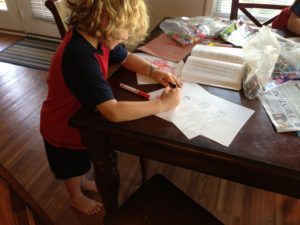 Knowing what your child is capable of drawing at their developmental level is crucial to understanding what they choose to draw, especially for these type of portraits! For example, a child around the age three to five may use stick figures to represent themselves or others (completely normal and appropriate for this age). However, if you have a child around 10 years old that mainly illustrates with stick figures it would be more concerning and could reveal possible issues of depression, low self-esteem, or even developmental delays.
Knowing what your child is capable of drawing at their developmental level is crucial to understanding what they choose to draw, especially for these type of portraits! For example, a child around the age three to five may use stick figures to represent themselves or others (completely normal and appropriate for this age). However, if you have a child around 10 years old that mainly illustrates with stick figures it would be more concerning and could reveal possible issues of depression, low self-esteem, or even developmental delays.
On the other hand, if children are drawing things that are inappropriate such as too much detail around the genitals, or heavy emphasis on those areas, this would cause concern for possible sexual abuse. If you notice any of these concerns, contact a professional to help you and do not try to interpret your child’s play or drawings on your own. There is so much that I could give you today, but I don’t want to give you too much to become dangerous.I really want this project to be fun, so the information that I give you should be used to start conversations between you and your child, not cause you anxiety. Use the resources that I provide to ask questions and dialogue with your child instead of of you standing back and examining their work. The purpose is to open communication within your family, not to “figure them out”. Believe me, that may never happen (hehehe!).
Here are a few things to consider as you watch them draw. Don’t forget to read up on the developmental drawing stages, first!
1. Are there any body parts missing? I lack of arms could show feelings of helplessness. However, this is a developmental milestone for a child to consider drawing arms, hands, and fingers. For example, Jack forgot to draw his arms. After he was done I stated “Jackson, I noticed your picture doesn’t have any arms.” He was surprised that he forgot, so when he drew his arms, he drew them very long with strong muscles attached. This child clearly does not feel helpless or out-of-control. In fact, when I did some research, it said “control others and desires strength and power, although longer arms can also signal a desire to reach out to others.” Either way, that is definitely Jack! He also had his thoughts in thought clouds, wondering about the upcoming move. He drew a heart around all of it and colored it in saying, “Everyone will stay close to my heart.” Some of his feelings were triggered today by not having a great time in childcare during the morning (enter Mom-guilt, here.)
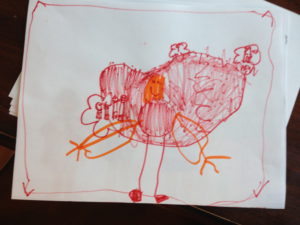
2. Is anything hidden? Some children may hide limbs or not to draw a part of the body because they don’t feel confident enough to draw. Geez, I even felt the pressure as I was drawing my own picture! There are some parts of the body that I am not good at drawing- So I either didn’t draw it at all, or found a way to conveniently not make room on the page for it! It’s important to realize that children may feel the same way. If there’s any hesitancy from the child to draw, they may not feel secure enough in their ability to draw it well. This provides a great opportunity to talk with them about their feelings and provide positive feedback on their effort. After our drawing time today, I looked back and realized that should not have drawn with such detail in my own picture. It would have been better to have drawn a more cartoon version of the family portrait. Too much detail could have made Jack self-conscious in his own ability to draw, or draw well.

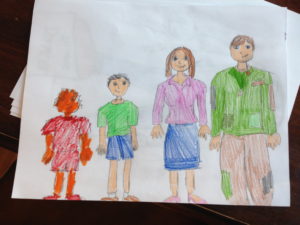
3. Head – Did they draw their head larger than their body or much smaller than their body? Larger could be interpreted as desiring to feel smarter or better academically, whereas small could show insecurity.
4. How big is their portrait on the page? Did they take up the whole page (aggressiveness or overly confident), or make themselves tiny in the large space (Insecurity)? I’m sure you can tell by Aidan’s picture where he stands!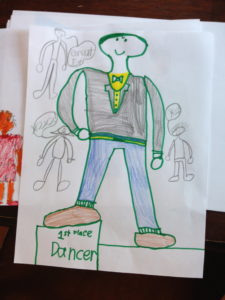

5. Where did they invest the most detail? This can be a conversation starter- “I noticed you spent a lot of time on ____”
6. What kind of action did they show themselves doing? This can reveal thoughts or confidence in things they are good at or what they are feeling is happening in their current relationships.
7. Lots of time erasing can show anxiety or worries of perfection.
8. What kind of smile is on the face? Obviously a smile or frown shows emotion, however if the child does not draw a mouth, it can show feelings regarding whether or not they have a voice in the home or the ability to share their thoughts and feelings.
9. Comparing the resources that I found to their drawings. I didn’t necessarily learn anything new about them but it was fun to see their drawings reflect what I thought to be true about each of their personalities.I also wanted to share with you the emotion faces that I often use. I pulled this out as well during our drawing time and the boys had a fun time laughing at some of the silly faces. It will definitely serve them during some of our other play therapy moments.
My Feelings Activity Book (Especially great for pre-K level who are just beginning to understand emotions)
-
Play Therapy at Home, Day 7: Sand
Well, I tried to coordinate “sand day” for the beach- but then I guess it’s a good thing that it didn’t work out that way because not everyone reading this has access to a beach!! More of you probably have a sand box in your back yard, though, and sand has turned out to be one of my favorites! There is something about the cool sand that children love, digging their fingers in and burying their arms as far as they can go. It’s relaxing, just like when we adults long for sitting in the sun on the beach and feeling the waves wash sand over our toes. So sand plays a huge role in play therapy. The sand tray also creates a space for a child to develop a new world using toys or drawing in the sand itself.
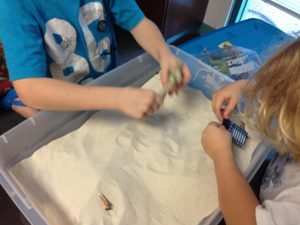 The boys have been begging for me to take them to my office and show them my sand tray and today was a perfect day for it. I shared with them the rules, which is really only one: Keep the sand in the box. Out of all the children I have worked with, guess who could not follow that rule? Yep… that would be my kids… maybe it was because the two of them were together… regardless- it was cra-cra.
The boys have been begging for me to take them to my office and show them my sand tray and today was a perfect day for it. I shared with them the rules, which is really only one: Keep the sand in the box. Out of all the children I have worked with, guess who could not follow that rule? Yep… that would be my kids… maybe it was because the two of them were together… regardless- it was cra-cra.Oh well, we are playing, right? Who wants to play with someone who can’t step out of the rule book? So I tried to relax a little bit, knowing at the end, the vacuum and I were going to have a date.
Sand is a great tool for relaxation. Often times I will start off giving them a chance to just feel the sand. We will talk about our week or our day as they strum the sand between their fingers. The teenager I mentioned earlier loves the sand. Sometimes we will sit and doodle on the floor and talk (I love my job), but mostly she plays in the sand and picks out the tiny pebbles and collects them in the corner. I don’t know… that’s her thing… but it works. Really, it’s about talking without eye contact. It’s about shared experiences, doing something side by side instead of me standing over them. It is so easy to do that with my own kids, to have them color while I busy myself with something else, when some of the best talks happen when I am sitting on the floor too doing whatever they are doing.
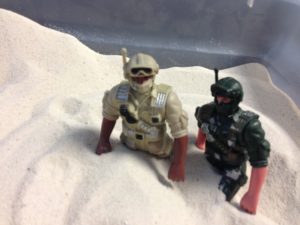 When I asked about how they felt in the sand they described that it felt “great” and “so soft” and they could “play in it forever!”
When I asked about how they felt in the sand they described that it felt “great” and “so soft” and they could “play in it forever!”Sand is also great for creating an alternative world. I have seen it be a house where kids draw lines to separate bedrooms as they play with action figures in the “house”. I have also seen it be heaven. One of my favorite moments was going on a journey up into our “sand” heaven to visit a child’s dad and spend a day with him there. What a tour that was! The most therapeutic part was when it was time to say good-bye and the child got to be the one to leave and go home because she missed her house and friends.
After I let the boys play and dig for a while, I asked if they would like to pick one of the action figures as “them”. I had a bunch of Star Wars figures so it turned out to be Aidan, Jack, and Daddy. I got to be Daddy. Role playing is a great way to hear from kids what they enjoy about their relationships as well as what they wish could be. I loved watching the boys welcome Daddy home from work and have a tickle fest before bed. Aidan is definitely my affectionate one so he enjoyed giving lots of hugs and kisses and wrestling with Dad. Jack tackled him too of course, but spent more time burying his action figure (haha!)
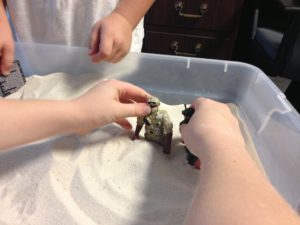 Speaking of themes, some that you could look for (but not over interpret) are actions like consistently burying “certain people”, angrily burying, and creating valleys that separate people from one another. I will be constantly pointing out the danger of interpretation as we move through our 20 days, but when you see something curious, don’t be afraid to ask about it. If you don’t feel like you can ask yet, then keep watching and see what happens. Some of the best therapy in play is not anything we ever do- but letting them play it out. Kids will play the same story line over and over again, but that is their way of making sense of something. When we step aside (both our own agenda and physically step aside) they will often play it out and work out a new ending. As adults we talk it over with a friend and a banana nut muffin, but kids don’t have that ability, so they act it out. Don’t be alarmed if it is a repetitive storyline. Instead, ask to join in as a character at some point- you will definitely have the story line down!
Speaking of themes, some that you could look for (but not over interpret) are actions like consistently burying “certain people”, angrily burying, and creating valleys that separate people from one another. I will be constantly pointing out the danger of interpretation as we move through our 20 days, but when you see something curious, don’t be afraid to ask about it. If you don’t feel like you can ask yet, then keep watching and see what happens. Some of the best therapy in play is not anything we ever do- but letting them play it out. Kids will play the same story line over and over again, but that is their way of making sense of something. When we step aside (both our own agenda and physically step aside) they will often play it out and work out a new ending. As adults we talk it over with a friend and a banana nut muffin, but kids don’t have that ability, so they act it out. Don’t be alarmed if it is a repetitive storyline. Instead, ask to join in as a character at some point- you will definitely have the story line down!The sand on the carpet was worth it. I already knew the boys had a special bond with their Dad, but seeing them play out their favorite parts of the day was awesome.
-
Play Therapy at Home, Day 6: Story Time
 I love story time. To be honest, I have gotten away from it a little. I used to be so good at laying down with my children at night and listening to them read. What a joy it is to hear them learning and sounding out words. So, I was looking forward to this one. We waited all day. Not only was Jack going to read to me, but I knew that it is a more special time than any to have those wonderful talks.
I love story time. To be honest, I have gotten away from it a little. I used to be so good at laying down with my children at night and listening to them read. What a joy it is to hear them learning and sounding out words. So, I was looking forward to this one. We waited all day. Not only was Jack going to read to me, but I knew that it is a more special time than any to have those wonderful talks.I often encourage parents, that if they really want to know what’s going on with their children, bedtime is the best time. There is something about those droopy eyelids that work like a truth serum. Of course, it doesn’t happen instantly, but if you make it routine to tuck your kids in bed at night, or say night time prayers, or read books together it becomes something they look forward to. Add to that a question or phrase that you say to them every night.
“How was your day today?”
“Was there anything you wanted to talk about tonight?” or
“Do you have any questions about _____ that happened today?”
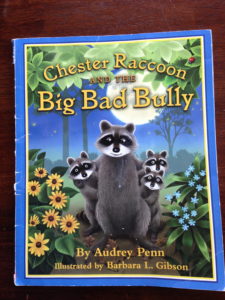 They may not answer all at once, but if you continue to do this night after night, you will eventually find them testing the safety that you are providing by asking that question or opening up.
They may not answer all at once, but if you continue to do this night after night, you will eventually find them testing the safety that you are providing by asking that question or opening up.Story time is a great time to read books that open up feelings and that also teach how to handle them. There are so many wonderful books out there and I will give you a few of what I have. The teachable moments don’t necessarily happen the first time you read that book. It’s when you read them again and again, where they children know what’s going to happen next that they can really think about it and possible relate their own experiences. I once read a therapeutic book to a little girl about a boy who had stuffed all his feelings inside and it made him feel like there was a big angry ball inside his stomach. He tried lots of things to get rid of that angry ball in his stomach, including being mean to his little sister and ignoring it. Eventually he went to a magic lady who told him that if he tried to use words to describe how he was feeling and even talk about the bad things that happened to him, that big angry ball in his stomach would go away. He learned to talk, learned to paint, and eventually one day told the magic lady about the terrible thing that happened to him. Slowly, the big angry ball started to disappear as he learned to talk to those around him who were safe. We must have read that books three or four times before the little girl finally asked me if I was like the magic lady in the story.
Tonight, we read “Chester Raccoon, and the Big Bad Bully”. I honestly can’t tell you how many times we have read this book- so many I thought they were tired of it. But we had a little twist in our experience of it tonight. Jack did a great job reading it and I was reminded of how much I love to be read to and how this moment will be gone soon.
In the story, the bully is described as a prickly stone that all the forest animals help shape and buff so that he can be like the other stones. The mother in the story encourages the kids to realize that the bully may not know how to act differently and may need a friend. Being his friend and showing him how he can and can’t treat others will possibly help him learn to be a team player. What I wasn’t expecting, was for Aidan and I to have a conversation about how all of us need to be shaped and learn new things. Aidan is in a tough season of peer socialization. I encouraged him to trust Daddy and I as we teach him some important things about how to make friends, but also be a friend.
As I look back, Aidan taught me a great lesson. Just as much as he needs to trust me, I need to trust God as he is shaping me. I may not know how to act different. It may have always been my “way”. But that doesn’t make it the best way and certainly doesn’t give me the right to say everyone else will just have to deal with it. I need God, and I need the people he has put in my life to help shape me in to a person that works better within the community.
Here are a few of my favorites that we own.
 What are your favorites?
What are your favorites?
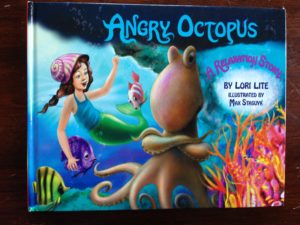
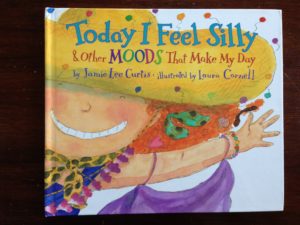
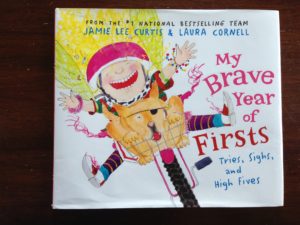
-
Play Therapy at Home, Day 5: Play Dough
Raise your hand if you love Play Dough!!! ME!!! It is the perfect rainy day activity (yes, we are still drowning here). This time, Jack was the first to mention it so I was excited to pull it out for today’s play time.
Play therapy includes what we like to call “directive play” and “non-directive play”. Obviously, directive means that I ask the child to do specific activities (remember when I asked them to paint what they would miss after we move?). As a therapist, we have many sessions of non-directive play building the relationship and giving the child time to enjoy the room. As a parent, we have to rely on our discernment to help us know when we can be directive and when to go with the flow. Every child is different too, so some may enjoy waiting for what the directions are (Aidan) and others who may want the freedom to be creative (Jack). Both styles are equally important and both can be therapeutic. All that to say, make sure you pay attention to your child during play time and be willing to let them choose. Having control is powerful, even for us adults.
Think for a moment you are a little person. Every waking moment is determined for you.
Play time should definitely be a time for children to use their imagination any way they choose! Back to Play Dough!
The last time we played Play Dough, Jack and I had made a candy store together, so he really wanted to continue that theme. I was finishing some dinner prep so I told the boys to do whatever they wanted while I finished up. I could tell that they were catching on that each day I was going to ask them to try something specific, so I was feeling the need to have us be more non-directive play to keep the balance. My plan was to give them time to be creative and just watch how they played but have a directive option ready. Developmentally, Jack is still in a place of learning physical creativity. He is just now figuring out how to make his own creation out of LEGO’s, so asking him to do something complicated with Play Dough needed to be an option, not a challenge. Honestly, anything he decides to try and create is a huge deal. I definitely want to give him an option, but be open to him doing his own thing and celebrating that.
When I was done with my dinner prep, Aidan was especially up for the challenge. I asked them if once they were done with their current creation, if they would be willing to make themselves out of the play dough. As an extra challenge to Aidan, I asked if he would come up with a way to show me what he liked most about himself. When he got to making his face, it was funny to hear him talking to Jack about not wanting to use red, because that would make him look angry (HAHA!) I love his creation of himself.


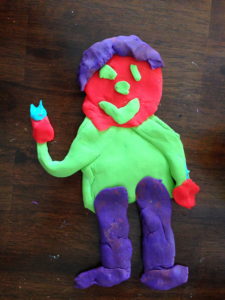
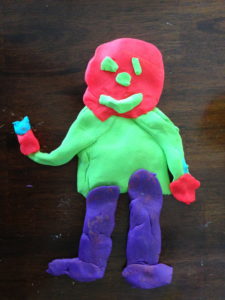 As they make a play dough version of themselves, pay attention to some of the details they choose to use or leave out. We will talk more about this when we get to drawing in Play Therapy. Are they leaving off hands or feet? I don’t want you to look too deeply into this- interpretations can get you into trouble, so make it a fun conversation and consider their developmental stage. Children under six years of age are likely into stick figure drawings and may not even consider hands- they haven’t even considered clothes! For example, when Aidan was done, I said, “So I noticed you don’t have any hair.” He gasped, he hadn’t even thought of that! Of course he should have hair!! (And really, how many people would go through the extra effort with play dough to make hair- well, maybe me- but that is because I didn’t want to be bald). He quickly made hair, and that was that. He put a LEGO in his “play dough-Aidan’s” hand and told me how great he was at building things. We have been talking a lot lately about engineering and he has taken a big interest in that, so I was pleased to see that he really does like that part of himself.
As they make a play dough version of themselves, pay attention to some of the details they choose to use or leave out. We will talk more about this when we get to drawing in Play Therapy. Are they leaving off hands or feet? I don’t want you to look too deeply into this- interpretations can get you into trouble, so make it a fun conversation and consider their developmental stage. Children under six years of age are likely into stick figure drawings and may not even consider hands- they haven’t even considered clothes! For example, when Aidan was done, I said, “So I noticed you don’t have any hair.” He gasped, he hadn’t even thought of that! Of course he should have hair!! (And really, how many people would go through the extra effort with play dough to make hair- well, maybe me- but that is because I didn’t want to be bald). He quickly made hair, and that was that. He put a LEGO in his “play dough-Aidan’s” hand and told me how great he was at building things. We have been talking a lot lately about engineering and he has taken a big interest in that, so I was pleased to see that he really does like that part of himself.
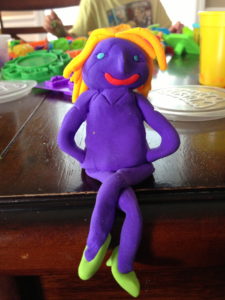 At another point, I asked Jack if he would like me to make a Play Dough-Jack which would have given me an opportunity to show him how I viewed him, but he did not like that idea. That is a bit daunting for Jack to see how others might see him, but when he changed his mind later, I told him I would rather see him do one of himself someday and that I though it would not be a good idea for me to do it before he does. I purposely said this to show him that his idea of himself would be great no matter what.
At another point, I asked Jack if he would like me to make a Play Dough-Jack which would have given me an opportunity to show him how I viewed him, but he did not like that idea. That is a bit daunting for Jack to see how others might see him, but when he changed his mind later, I told him I would rather see him do one of himself someday and that I though it would not be a good idea for me to do it before he does. I purposely said this to show him that his idea of himself would be great no matter what.Play Dough can be used in many other ways. I have a teenager that I work with that was having trouble talking to her mother about some heavy topics. After many sessions of talking (through drawing and sand) and getting her communication more comfortable we were ready to talk to mom. When I brought mom in, I was holding and playing with play dough in my hands. When it came time for the teenage girl to try talking to her mom, I offered the cool, soft, play dough to her mom to play with. I immediately noticed a difference in mom’s ability to remain calm. Several sessions later, the teenage girl told me she tried talking to her mom on another occasion at home, and beforehand gave her mom some play dough to hold on to. Now, it is a funny “cue” for them that “we are about to have a serious talk and I need you to listen.”
Play Dough can also be great for teaching anger management to children. If they are too young to make more complicated creations, you can make a ball and throw it at a target, smash and pound it on the table, make it into someone else you are angry with and smash the dough instead of using hurtful words in real life. It can also give a child a place to try using words as a “dress rehearsal” before being confronted with the real thing. For more ideas in using play dough, try here and and fun family game on expressing frustration here.
I also have this book on “101 More Favorite Play Therapy Techniques” and love this excerpt they described using play dough. To read it, click here.
-
Play Therapy at Home, Day 4: Games that Teach
The sun peaked through the clouds today for about an hour and I think every kid in the neighborhood came out to see it. That’s probably not true- the parents probably threw them outside. I connected with some neighborhood moms as I watched children running through the mud and using grass puddles as slip-and-slides. What a happy moment to feel the vitamin D! After a wonderful afternoon filled with grown-up time with lunch guests, the boys were itching for time to connect. Sometimes, no matter how tired you are, you just know the evening needs to balance out with family time. We usually fill this time with cards or a board game around the table. A quick game of UNO or even go-fish “fills the bucket” of connection every time.
Play therapy is not always about searching for facts and feelings. Often time, play therapy is used for teaching social skills and working through relationships. Many children I work with begin therapy because the parents see anger or anxiety symptom. However, once you know the facts, therapy is about building communication and working through social situations they feel stuck in. For this reason, play therapy often goes well into therapy with adolescents. Believe it or not, I have teenagers that love to come in and rake their fingers through the sandbox as they talk about their problems. After all, they are only children in bigger bodies (I mean that in the best way!).
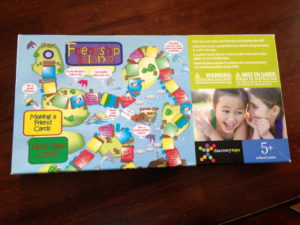 Tonight we played one of the boys favorites. It’s called “Friendship Island” and I ordered from Discovery Toys. I don’t remember it being this expensive, but here it is on Amazon.com. I highly recommend buying this game if you have very young children who could play this for years or if you have a child with any developmental delays that will be working through complicated social situations for a long time. Don’t let the price sway you, though, because today I want to talk about how you can make one of your own.
Tonight we played one of the boys favorites. It’s called “Friendship Island” and I ordered from Discovery Toys. I don’t remember it being this expensive, but here it is on Amazon.com. I highly recommend buying this game if you have very young children who could play this for years or if you have a child with any developmental delays that will be working through complicated social situations for a long time. Don’t let the price sway you, though, because today I want to talk about how you can make one of your own. 
The concept of Friendship Island is that as you move through the game board (think Candyland) the players answer questions about what they would do in various situations involving friends, making friends, and keeping friends. Friendship Island gives different rules for playing based on age groups allowing younger ones to move easier throughout the board and even ask other players for help. The player rolls the dice and moves that many spaces. Based on which color they land on, the player is asked a question off of a card of that color. Questions are true/false questions, multiple choice, and “describe a time when you ____”. The questions give the children an opportunity to think of times when they shared with someone else, waited their turn, or took opportunities to try to work things out with a friend rather than tattling.


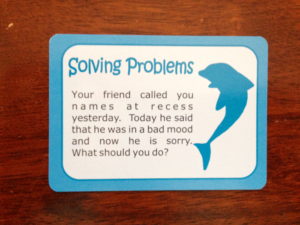 If you want to make your own, you can use most any game board (Candyland, Sorry, etc). If you want to get super crafty, you could use index cards to write out questions. If you don’t have hours on hand to do that kind of detail work, consider having certain colors or certain spaces on the board connect with a theme. For example, yellow spaces are about how to make friends (Think of questions that have to do with how to ask a friend about their interests, avoid bragging, introducing themselves, playing along with the other child’s games, and how to give compliments). Another color can be the theme of keeping friends (Knowing when to tell a parent or teacher, how to work through a disagreement, how to handle hurt feelings, rumors, and playing along together). Other colors could represent describing successful moments they have had. Easy questions that give you an opportunity to praise a child for good decisions they made taking turns, sharing, working things out with a friend or sibling, told the truth, etc. Don’t make this too hard on yourself. Keep it simple, your kids will appreciate it. Even easier, have the kids help you come up with the questions that go with each theme.
If you want to make your own, you can use most any game board (Candyland, Sorry, etc). If you want to get super crafty, you could use index cards to write out questions. If you don’t have hours on hand to do that kind of detail work, consider having certain colors or certain spaces on the board connect with a theme. For example, yellow spaces are about how to make friends (Think of questions that have to do with how to ask a friend about their interests, avoid bragging, introducing themselves, playing along with the other child’s games, and how to give compliments). Another color can be the theme of keeping friends (Knowing when to tell a parent or teacher, how to work through a disagreement, how to handle hurt feelings, rumors, and playing along together). Other colors could represent describing successful moments they have had. Easy questions that give you an opportunity to praise a child for good decisions they made taking turns, sharing, working things out with a friend or sibling, told the truth, etc. Don’t make this too hard on yourself. Keep it simple, your kids will appreciate it. Even easier, have the kids help you come up with the questions that go with each theme.
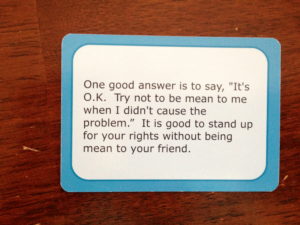 One important rule in a game like this is that (especially for younger ones) there doesn’t need to be a winner. This is one of those times when everyone wins. I know there is a lot of attention on our generation for not having “losers” in sports and games. The movie Parental Guidance was AWESOME and I highly recommend it, not to mention it is hilarious- it gave me a great perspective on how others might see some of my parenting decisions. But for this game, winning promotes openness in the discussions. The last thing you need is a frustrated 4 yr old who is more concerned about losing than thinking about working through the idea of sharing.
One important rule in a game like this is that (especially for younger ones) there doesn’t need to be a winner. This is one of those times when everyone wins. I know there is a lot of attention on our generation for not having “losers” in sports and games. The movie Parental Guidance was AWESOME and I highly recommend it, not to mention it is hilarious- it gave me a great perspective on how others might see some of my parenting decisions. But for this game, winning promotes openness in the discussions. The last thing you need is a frustrated 4 yr old who is more concerned about losing than thinking about working through the idea of sharing.I love this one, where they used paint swatches to glue a new game board.
I also love this one, that someone made for a child with Autism, but issues very relevant to all children.
Let me know if you need more examples of questions and scenarios. And don’t forget to think out some good answers! Be vulnerable yourself and tell your children about times when you didn’t make good decisions, how you felt, and when you struggled in a relationship. Tonight, I had the opportunity to tell my boys that even as a grown up when a friend stops talking to me, I am tempted to feel like they don’t want to be my friend anymore. Yet, the best answer is to go to them and talk to them about it in order to find out if I have done anything wrong. This not only reminds them that I am human, it also shows them that adulthood is not going to be perfect and free of hurt.
What friendship struggles do you see your children struggling with?
-
Play Therapy at Home, Day 3: Pick up Sticks
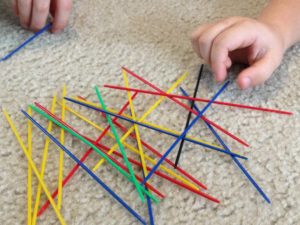 I’ll be honest. We’ve been on vacation for 2 weeks and the last part of it has been staying at home. A majority of our time during these two weeks have been monsoon rain storms. It seems no matter where we went, rain followed. I am sick of rain, and I think we are all beginning to get sick of each other. The boys are fighting, I am finding reasons to run an errand (surely we need something from the store, right?), and Matt is taking as many naps as possible before returning back to work. So when I started to think about what play therapy technique I was going to share with you today… well, let’s just say I was not sure I was up for “playing” with anyone. But, I try to be a woman of my word… so I needed something that took little effort from all of us. After some research, I found one using Pick Up Sticks! Thankful for having some of these annoying little sticks that seem to find themselves all over the house, I grabbed them and headed up to the boys room. If you don’t have these, you can make paper strips, use different color straws, or goodness… I bet I could have used Lego Bricks and had them build a tower as they chose their colors.
I’ll be honest. We’ve been on vacation for 2 weeks and the last part of it has been staying at home. A majority of our time during these two weeks have been monsoon rain storms. It seems no matter where we went, rain followed. I am sick of rain, and I think we are all beginning to get sick of each other. The boys are fighting, I am finding reasons to run an errand (surely we need something from the store, right?), and Matt is taking as many naps as possible before returning back to work. So when I started to think about what play therapy technique I was going to share with you today… well, let’s just say I was not sure I was up for “playing” with anyone. But, I try to be a woman of my word… so I needed something that took little effort from all of us. After some research, I found one using Pick Up Sticks! Thankful for having some of these annoying little sticks that seem to find themselves all over the house, I grabbed them and headed up to the boys room. If you don’t have these, you can make paper strips, use different color straws, or goodness… I bet I could have used Lego Bricks and had them build a tower as they chose their colors.So if you don’t know how to play Pick up Sticks, it’s pretty easy. The game has a bunch of sticks made up with at least five colors. You drop all of the sticks into a pile on the table (a carpeted floor seems to work better for us). One at a time, each person takes turns picking up one of the sticks, hopefully without moving/disturbing any of the other sticks. In this version, we all agree what feeling goes with each color (blue= sad, red=angry, yellow=happy/excited, and my boys wanted green=sick and black=nervous). It doesn’t matter what you decide, as long as you all agree. Hearing them decide what colors go with which feeling can give you great feedback into what they might be feeling or have been lately. Here is the color-chart I referenced in day 1.
Once you decide, you can start the game, but as you choose a stick to pick up, you have to describe a time when you felt that feeling. So if you pull blue, you have to describe a time when you felt sad. As simple as this is (I was certainly thankful!), it can give you great insight to experiences your child has had.
In our stack of sticks, there was one black. Normally worth 50 points, it’s the one everyone goes for. Aidan for some reason kept going for this one even though it was at the bottom of the stack. You can get a lot from watching which colors children go for and which they try to avoid. Although I am sure he was conditioned to go for the black one, I could tell once he finally got it that he had a lot to process. He certainly tends to be the “nervous” type. He was the one to first name the black one “Nervousness” and even though Jack disagreed (he wanted mad), once Jack tried to name the red one, he conceded with Aidan.
When it came time to play the game, any fly on the wall could have told you we were all kind of tired of each other. As we chose our sticks we all kept getting stuck on green. I mean how many times can you conjure up feelings of “sickness”? I made a reference to one of my experiences where I was actually nervous, but felt sick in my stomach. For a moment, we talked about how when you keep bad feelings inside, it can sometimes make your stomach (or body) feel “yucky” and maybe even sick.
By the end, we had shared with each other moments of upcoming nervousness (of course about moving), and moments of joy (my favorite). Sad feelings revolved around the end of the school year last year. I don’t know if they would have had the same experience in a civilian school, but we were blessed this last year to have teachers who really care about our military kids. Jack’s kindergarten teacher had a PhD in Education, her dissertation on “Military kids During Deployment” (that will certainly not happen ever again!). They both were sad to say goodbye to their teachers, but it also meant saying goodbye to fellow students who might move during the summer.
Our time together today was brief, but it was a great reminder that just when you think you are needing a break, 5 minutes of playtime can completely change your perspective on your relationship with your kids. Isn’t that the message of quality time? Anything of “quality” is good, pure, and full of something, otherwise it wouldn’t be “quality” right? Whether it’s five minutes of what Matt and I like to call “face-time” with your spouse, your children, or with God- it can sometimes be exactly what you need to change your attitude.
Happy Playing!!
What do you do when you are sensing your family needs a break from each other?
-
Day 2: Storytelling With a Twist
My idea behind doing these 20 days of play therapy is to show you that you can do everyday activities with your little one that also give you insight into some of their inner thoughts. I know for some of you, the temptation is to obsess over knowing these inner thoughts of your child. Carrying a child in your body and nurturing their existence in this world can make it difficult when your child begins to think independently, leaving you clueless to what’s happening in that little head. I watch mothers, well into the child’s adulthood, remain overly attached because they feel they need to know exactly what they are feeling- to the point they want to feel it with them. This is a recipe for disaster for this adult-child’s marriage.
Remember that your child’s heart and soul are to be tied to their future spouse. God designed this for the protection of their unity. The sooner we realize we are not meant to fully “get” them, the sooner we will be content with the relationship we are given with this person. This should push us on our knees more often, surrendering our control to the Creator who knows everything.
With that being said, on to Day 2! Storytelling…
We had an hour drive to Savannah to run errands, so this was perfect to do in the car. Knowing that we were all staring straight ahead made it easier for vulnerable moments in the discussion and an occasional turning around to comfort little eyes who needed connection.
Here is how it works.
1. The child gets to tell a story that includes characters and any storyline they want- as long as it is not a story they have heard before (no books, movies, video games, etc). Although they could use characters they know (Aidan asked to use Batman) I would encourage the child to come up with an entirely new character.
2. I would normally have older children go last, since their ability for detail can make younger one’s efforts feel minimized or “not as good”.
2. You can ask question during their story to help clarify characters and events (as long as it doesn’t become a barrage of them that interrupts the process). For example, you can help them start off by asking “How does a good story start?” “Is this person a boy or girl?” “How did they feel when that happened?” “Why did they decide to try [that]?”
3. Try to pay attention to characters that sound familiar, sound like the child or family members, or part of the storyline that relates to an experience the child has had (bullies, loss of someone or something, etc).
4. Once their done, use their same characters to re-tell the story that stretches their understanding or coping. If they are younger and need help, you can retell it and have them help you. How would you end it differently? What would that character learn from the new ending? Encourage older children to retell their own story and figure out the morale of the story (3rd grade +) or what the character learned.
I’ll tell you how this played out for us. At first, the boys seemed confused. They asked a lot of questions about telling stories they already knew. Once I gave an example of my own story, interestingly enough, Aidan asked if he could tell a dream he had. This was perfect. Storytelling with dreams, especially bad ones, create a great opportunity to re-write the dream- an effective technique for ending or altering re-occurring nightmares. Jack was a little resistant (being 6, he had a bad attitude already from being tired). That’s okay- Aidan (9) is always game for going first.
Aidan, who is coming out of the stage of using fantasy for coping, told a dream involving zombies that were moving on the cover of a magazine on the stairs. He ran upstairs and looked out his window to find many more zombies coming toward the house. This was the point where he woke up (I remember him coming to get us in tears). When we asked for him to try to come up with a new ending, he played out violent acts on the zombies (even though he’s never seen a zombie movie, this is the new playground hide-and-seek game- UGH!!). We didn’t stop him, even though I didn’t like Jack hearing of zombies getting their limbs ripped off, so as to give him the opportunity to finish. Since he is old enough to cognitively think through fantasy and reality, we asked him afterwards if zombies were real. He said “No”, so instead of us re-telling the story we asked him how he could re-tell the story again without violence considering they were imaginary.
Resist the urge to “do the work” for the child. You will often find their own creativity much more powerful than yours. In fact, self-discovery is always the best way to “catch” new learning.
Believe it or not, Aidan closed his eyes and told himself (in the dream) that “Zombies aren’t real”. He took the magazine to a shredder and shredded it into a million pieces and looked out the window to find they were gone (LOVE IT!!). It was only then that I added, “You know, if it is your dream, you could imagine anything you want outside that window. Pool parties with all of your friends, all eating your favorite ice cream, everyone happy and excited to play with you, and lush green grass all around.” This experience was perfect for him, since he is seeing more of reality and having to figure out what to do with fantasy that is scary. It also teaches him how to take his mind “captive” and control his thoughts, imagination, and fears. AWESOME!!
Now Jack was a different story, literally. I want to unpack for you the dynamics that played out more than his dream because they are just as important. Remember I told you yesterday that resistance is okay to work with where the child is at? He was tired, but he used this as an opportunity to test something very important. When it was his turn he blurted out that he has “lots” of nightmares, and some that would “freak you out” He elaborated slightly by saying that they involved “dying, and blood.”
**Most parents would freak out at this moment. I’m not saying that you shouldn’t, and if this was chronic and you saw daytime fears and phobias that interrupted your child’s functioning at home or at school then professional help is a good direction to go.
But for Jack, this has not been happening. I knew he had had some normal “night terrors” in the last year, but none that played out during the day. So when he said this in the car, I took it as testing.
Children often use “shock and awe” to test the adult.
In a sense, it is a way to see if they can trust you. Your reaction to them tells them whether or not you can “handle” them. This is an important moment! If you freak out, then you can send the message that their problems stress you out and scare you. If you beg for more information (which they may or may not have) it gives them extra attention- and we want to give them other kinds of healthy attention. The real test is to see if you can remain calm, let them know that you are safe, not worried, and will be ready to listen when they are ready to talk to you. Sometimes they won’t unpack these scary thoughts until you prove you are safe, other times they may open up. Sometimes you may find that they never had that dream to begin with. I had a child begin telling me about a dream and tried this testing. As I remained calm, her story oddly kept changing to become more “shocking”. Once she realized I was safe, she was finished and probably had a really fun time telling a crazy “out of the box” story. The morale was- I was safe, we had fun, and she could now tell me anything- GAME CHANGER!!!
So, Jack never did tell us about those dreams, but did tell a safer one. These “scary” themes are developmental, so I’m not worried. Even though he still into fantasy coping (yesterday’s painting about the future), he is realizing that there is an end to life. My grandfather passed away in October and that was hard for all of us. There were plenty of questions about that. This boy injures himself on a daily basis, but for him- blood can mean an emergency room visit- not life sustaining cells that keep our extremities alive. He is trying to figure all of that out, and to a 4-6 year old that may play out in dreams where these themes show up in no particular order. But it does give me opportunities to address loss, death, and life at other more opportune times.
His resistance (and age) kept him from retelling his story/dream. So Matt finished with his own story about two boys who went on a journey to find gold or silver to help feed their family. During their journey, they were forced by storms to enter a scary cave. With one flashlight out, they had to reserve the power in the second. After getting lost in the cave and feeling alone, tired, and scared, they turned off their light and faced the darkness. It was only when it was dark did they notice moonlight piercing through some cracks and the walls glittering with twinkling lights. As they took out their little hammers and began to chisel away the cave walls, they found the walls were covered in diamonds. To address the morale, he asked, “So, the boys never expected strong storms, getting lost in a caves, and feeling afraid in the dark. What do you think they learned?”
To which the boys came up with “Good things can come out of bad experiences!” Perhaps Jack will test that theory later by sharing more of his own scary moments.
For more about how you can use storytelling, visit here.
-
Day One: Part 2, Painting
So after my failed attempt to lovingly serve my boys a turkey sandwich with acceptance and unconditional positive regard, we cleared off the table for painting. I personally love painting with kids. It’s fun, easy to take out and clean up provides great insight through colors. Colors are powerful and are used to market products to us everyday. Green (also the color of money) actually makes you hungry. Blues and greys are calming, typically colors you find in spas. So naturally, the subconscious can choose a color to reflect a feeling without having to think about it first. This is excellent when working with kids. What colors do you think of when you are angry? Most will say red, or black. What colors do you associate happiness with? Most would say yellow, or orange. Pretty easy, huh? Try not to be too concrete on this. If your child has a another reason for choosing a color that seems like an odd choice, they could be associating that color with an object they saw that evoked that feeling or may not be at a place where their emotions are congruent (as you will see was Aidan’s case). For more on what colors can say about feelings, here is a great chart.
So, this past week, Matt and I introduced to our boys that a move in the winter time was highly likely. We wanted to give them plenty of time to process it and talk about it with us, especially if anything changes. I figured this was a great topic to start with.
After setting out the supplies, I gave them a couple of rules: “Paint stays on the newspaper, here’s how you clean your brush, and we will have several opportunities to paint. One painting will be on a topic, the other can be whatever you want! Which would you like to do first?”
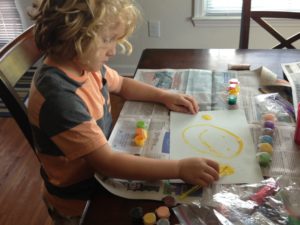 When it was time, I gave them the topic “I would love to see you paint a picture of how you feel about the upcoming move this summer. I’m sure you have many feelings when you think of it. You can use any colors you like, and paint any picture you would like about that. You can also tell me about it while you are painting, or wait until you are done.”
When it was time, I gave them the topic “I would love to see you paint a picture of how you feel about the upcoming move this summer. I’m sure you have many feelings when you think of it. You can use any colors you like, and paint any picture you would like about that. You can also tell me about it while you are painting, or wait until you are done.”I gave them a few options as well on how they could do it, just to open their minds to other possibilities. “You can paint one of what you will miss here, or what you are looking forward to there, or even draw a line down the middle and paint both. If you have another idea, that’s okay too!”
Jack, who is almost six and still in a stage of fantasy immediately picks up yellow. He is looking forward to a positive fantasy of change. Even though I see a big smiley face on his page, I ask why he chose yellow. He states because he is happy. As he paints and talks, I find out that he is excited about going to a new school and meeting new friends. He is my extrovert and can make friends quickly on a playground anywhere. Within minutes he is following a game someone else started, or leads out on his own asking others to join along. His heart is usually only pricked with the pain of hurt in well
established relationships. When I ask him if he will be missing anything here, he only says he will not miss Bullies. He had a girl that he didn’t like in class last year and he chose blue because he was happy to be leaving her and an giant red “x” to show “it’s over.”
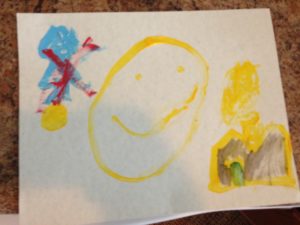
Aidan’s what a bit more intriguing. He is older, now coming out of the fantasy stage of development. He is shifting his focus more towards peers, playing with others, and developing who he is as he relates to peers. Of course this will peak as he gets into adolescence. Being that he is also interested in details, he wanted to make a list rather than a picture. I encouraged him to be creative and do his best to put a picture to his feelings rather than list words. This was a good challenge to him as he normally pushes down his feelings until something emotionally pricks him hard enough.
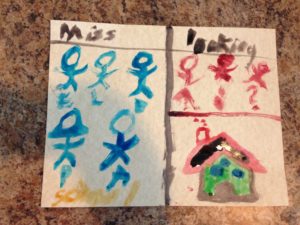 He opted for the split page of what he would miss and what he is looking forward to. When I asked about color choices, he told me he chose blue for the side he would miss. “When you sing the blues, blue is a good color for sad.” He then painted his “list” of friends he would be saying good-bye to and wrote “school” under that side as well. Interesting, he chose the color red for what he was looking forward to. When I asked him why red (Red usually shows a less positive
He opted for the split page of what he would miss and what he is looking forward to. When I asked about color choices, he told me he chose blue for the side he would miss. “When you sing the blues, blue is a good color for sad.” He then painted his “list” of friends he would be saying good-bye to and wrote “school” under that side as well. Interesting, he chose the color red for what he was looking forward to. When I asked him why red (Red usually shows a less positive emotion), he said he thought red was an exciting color. I wasn’t going to doubt his choice- especially after our turkey sandwich episode, howeverit felt in-congruent to me. Knowing what he would be facing in a move (he has a memory of leaving Colorado and making friends here), “exciting” didn’t seem what he was expressing, even in his voice. Without making leading statements, I said that many people choose red for other emotions and asked what else he might be feeling. It was then he came to describe nervousness as a better description. He was unsure of how he would feel trying to make new friends. Under that though, he decided to mask over or re-write that feeling that came up by drawing an image of the house he was looking forward to. Green was certainly a more confident, happy color for him. Perhaps having a new house that is still our home will bring him great comfort. Maybe I’ll have Italian bread for him and be ready to make it “his way.”

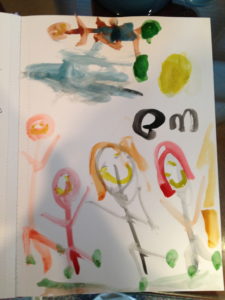 Finally, here is one of my favorite paintings from a 5 year old client I worked with for a year. She gave me permission to take a picture of it and keep it. She lost her father tragically and spent a majority of that year coming to terms with him being gone. Our goal was for her to see him as “with her” but okay with him not physically being here. After months of angry and sad paintings with red and black and grey reflecting all of them together with sad faces, this was her final picture. Here she shows her with her siblings and mother all together without him. Notice how they all have smiles on their faces! All happy colors and green grass. She is moving to a new house in this picture and her father is right where he needs to be, always with them, but in heaven (he also has a yellow smile that is hard to see).
Finally, here is one of my favorite paintings from a 5 year old client I worked with for a year. She gave me permission to take a picture of it and keep it. She lost her father tragically and spent a majority of that year coming to terms with him being gone. Our goal was for her to see him as “with her” but okay with him not physically being here. After months of angry and sad paintings with red and black and grey reflecting all of them together with sad faces, this was her final picture. Here she shows her with her siblings and mother all together without him. Notice how they all have smiles on their faces! All happy colors and green grass. She is moving to a new house in this picture and her father is right where he needs to be, always with them, but in heaven (he also has a yellow smile that is hard to see). -
Play Therapy: Day One The Basics
There is nothing like being excited to start a new project to benefit all the other stay-at-home moms of the world and then be completely humbled by the frustration of little people with whom you are about to do awesome stuff with. Isn’t that how it goes? I mean come on. I am riddled with guilt everyday over all the things I could and should be doing with my children, knowing that they will go to their own therapist some day complaining of how I didn’t spend time enough time playing with them, And then the therapist will look at them with concerning, understanding eyes and ask “What did you mom do for a living?” And they will say I was a therapist. So the pressure is on, or at least until I let it go. Today, I just take a deep breath and remind myself that I am human and someday they will accept that too.
So, day one. I’m pumped about painting with them, but tell the boys we have to have lunch first. The next thing I know, I am in massive conflict with my nine year old who wants his turkey sandwich just like Subway. Now, I am all about options. In fact, that is the first think you should know about play therapy. You can’t walk in with a complete agenda- there has to be room for creativity. So I decided to set the atmosphere.
“You can have a sandwich, but anything but PB&J, just for today.” Well the fight was on.
“Only if it’s a wrap”
“I’m out of wraps. What if you be creative and make one like Subway? You can choose your ingredients!” (Said with great inflection and positivity).
“Can I have it toasted and on Italian bread?”
“Ummmm…. Sure… but I don’t have Italian bread, just my awesome homemade bread.” (Said with less inflection and less positivity). Here is where it got bad. My nine year old who is extremely detailed starts to place his Burger King-type of order. He wants it toasted, with Ranch, but wants the lettuce and Ranch put on after its toasted. Of course, that can’t be done after the freakin’ cheese has stuck the whole thing together! “But that’s they way Subway does it!” (He says with great confidence). I’m beginning to lose it here, cause, geez kid- I’m trying to set the stage for healing and understanding and what I’m getting is a stand off over a turkey sandwich.
At this point, Matt walks in with a sly grin and says, “Glad you’re planning to do some play therapy with them, hun. Seems like you’ll have plenty to work with.”
We got through lunch with a little bit of compromise for both of us, reminders that we are NOT a Subway kitchen, another lesson in talking back, and a humbled Mom who is reminded that you can try your best but these are different personalities you’re working with. When you are the parent, you will only get so much from your child. That’s why a therapist is considered safe and disconnected. But what I want to arm you with is some tools to take to your play time so you can really listen to your children. So with that, let’s talk about a few basics.
- When you can, give them options on what they would like to play. Some days they will feel like painting, other days may be a sand day. (Tomorrow, I will be armed with more choices).
- Don’t ask leading questions like, “Doesn’t that make you feel sad?” Instead, try to use as few words as possible. Try, “When you think of [that], how does it make you feel inside?
- Kids open up more when you aren’t making eye contact. Playing side by side is less threatening and the brain is not multitasking on 2 things at once.
- Sometimes play can be how they are currently feeling and other times can be used to help them think ahead at how they will handle the future- try not to rush them into the latter.
- Put your phone in a different room! This is family time.
- If you or the child seems frustrated, or finished… end it. You may want to paint for 2 hours, but they may be done in 5 minutes and that’s ok.
So, there you go. I will share with you tomorrow how our first day went. I also hope to give you resources for each technique in case you want to read further. Remember, don’t take it too seriously, and don’t read into it too much. If you get concerned, call someone to help. As I go along, I want to hear from you on what areas I’m not covering or what you would like to see. Happy playing!!
